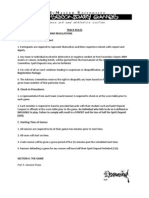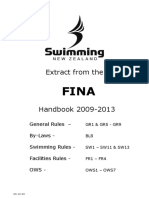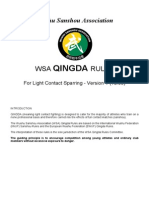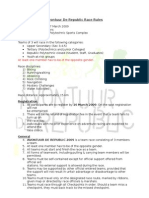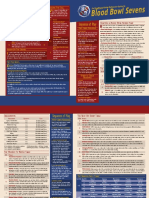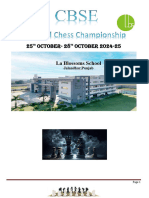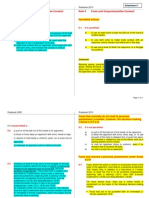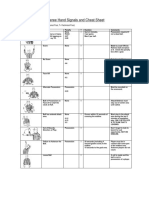IM IM703 and 5150 Rules and Regulations 2012
IM IM703 and 5150 Rules and Regulations 2012
Uploaded by
swrakanCopyright:
Available Formats
IM IM703 and 5150 Rules and Regulations 2012
IM IM703 and 5150 Rules and Regulations 2012
Uploaded by
swrakanOriginal Description:
Copyright
Available Formats
Share this document
Did you find this document useful?
Is this content inappropriate?
Copyright:
Available Formats
IM IM703 and 5150 Rules and Regulations 2012
IM IM703 and 5150 Rules and Regulations 2012
Uploaded by
swrakanCopyright:
Available Formats
Race rules (Sportordnung) IRONMAN, IRONMAN 70.
3 and 5i50 Races in Germany
IRONMAN is an individual sport and consists of swimming, cycling and running. The distances vary according to the event. IRONMAN (full-distance): IRONMAN 70.3: Distances for the 5i50 Event: 3,8k Swim, 180k Bike, 42,195k Run 1,9k Swim, 90k Bike, 21,1k Run 1,5k Swim, 40k Bike and 10k Run.
The three distances must be completed in immediate succession and in one day. The time limits (Cut-off times) for each single stage and the finish line (end of the race) will be determined in the competition information (Race Info) of each competition prior the event. The winner of each category at the IRONMAN European Championship and/or the IRONMAN 70.3 European Championship will bear the title Open IRONMAN European Champion/Open IRONMAN 70.3 European Champion, regardless of the nationality of the athlete. It is irrelevant for the ranking/prize money if the athlete is European or not. Area of application of this Race rules (Sportordnung) are the licensed IRONMAN and 5i50 events in Germany.
1 Basic regulations 1. The following set of rules guarantee fair and smooth proceedings of the race. It is decisive for the competition participation. The competition jury takes care that the competition is carried out after the regulations of this race rules. The competition judges (Referees) enthroned in the event, represent under the management of the organizer (race management) the competition court. 2. With his / her registration, the athlete accepts the Race rules (Sportordnung), the competition rules of the WTC (World Triathlon Corporation) and the rules and regulations of the relevant National Triathlon Association of the venue in their current legal form and in this order. 3. Through a mandatory, personal signature on the form Teilnahmebedingungen/Waiver the athlete accepts the conditions of participation. The signed form is required for the pick-up of the race package and needs to be submitted at the pick-up of the race package. Further the competition information (Race info) and the information as announced in the pre-race briefing are to be observed. This legal basis is intended for the purpose of a uniform and equal exercise of the sport. Compliance with and acceptance of this basis is a fundamental requirement for the participation in the mentioned events. If this Race rules (Sportordnung) refers to other regulations and they are contradictory, then the ranking shall be determined by the order of their listing. The preceding control decisions and the competition decisions being based on them are not contestable judicially. 4. Basic principles of the event are fairness and adherence to the regulations. It is forbidden to seek advantages by breaking these regulations. The athletes may not impede or endanger others, nor obstruct the proceedings of the race. The athletes must be polite towards other athletes, volunteers, referees and medical personnel. They will observe traffic rules and follow the instructions of the organizer, referees and medical personnel. The athletes shall show respect towards the environment and avoid pollution. 5. Each athlete himself is responsible for competing in a healthy and physically well-trained condition only. Doping is forbidden. With his registration, each athlete agreed upon the doping rules and blood limit values, which are mandatory for the event. With his registration, each athlete declares that he didnt violate prior or during the event the Anti-Doping regulations of WTC and/or the relevant national Federation. This guideline is substantiated by the organizers goal to guarantee a clean, fair and doping free sport and to let only those athletes adhering to this requirement participate in the event and be listed in the results.
1
6. The organizer reserves the right to alter the rules and regulations concerning the race proceedings at any given time. These changes are then binding, if the athletes are informed in writing or verbally at the pre-race briefing. 7. The participation in the pre-race briefing is mandatory.
2 Safety Regulations 1. Each athlete himself is responsible for the perfect condition and technical safety of his equipment and has to ensure that other athletes, volunteers and spectators are not endangered by his equipment. 2. If the equipment of the athlete does not correspond to the preceding default and/or the competition information, the athlete is not admitted to the competition. 3. If the athlete violates the rules accordant to section 1 during the event, he must remove the objectionable condition, as demanded by referees or race management, immediately. Failure to do so will result in the disqualification of the athlete from the race by the competition jury. 4. It is forbidden to carry equipment, which can in any way be described as communication or entertainment media (Mobile phone, iPod, MP3 player, camera, video-camera, etc.). It is not decisive if the athlete actually utilizes these objects or not. If an athlete violates this rule, the athlete will be disqualified by the competition jury. An immediate disqualification by a referee on the official race course, upon determination of the violation, is possible. 5. The carrying of glass bottles is prohibited.
3 Transition Areas / changing clothes 1. Only athletes in the race, volunteers and personnel with the according authorization are permitted to enter the transition zones. Coaches, private support staff and spectators may not enter the transition areas. 2. It is allowed to change clothes in the transition areas only. 3. The wetsuit may be taken off only in the transition area, at the place prescribed for it (changing tent, at the bicycle). On the way through the transition area the neoprene may be opened and be stripped off to the hips. 4. It is forbidden to ride the bike in the transition area.
5. In the transition area the bike may be only pushed. Therefore, the athlete is allowed to ride the bike only after leaving the transition area at the visible mark (Mount line). An infringement is punished with a yellow card in accordance with 12. 6. At the end of the bike course the athlete has to get off the bike before a visible marker (Dismount Line) in front of the transition area. An infringement is punished with a yellow card in accordance with 12. Whether the athlete hands over the bike to a volunteer, or needs to hang the bike on a bike rack by himself, regulates the respective competition information (Race info).
7. It is mandatory to wear a race top on the bike and during the run.
4 Identifiability of the athlete 1. Every athlete must be identifiable at all times during, before and after the race and in the official race areas (transition areas, Athletes Garden). 2. The form of identifiability before and after the race in the official race zones will be defined by the regulations of the organizer in the race invitation or the competition information (Race info) or at the pre-race briefing (e. g. wearing a specific wrist band, requirement to wear the timing chip when entering or exiting the official race zones, etc.). Infringement of this regulation can be cause for exclusion from the race or subsequent disqualification, regardless of the exact moment of determination of the infringement. 3. Wearing the race number (bib number) while swimming is not permitted. Any infraction will be punished with a yellow card in accordance with 12. The race number must be worn on the back during the bike split, in the front of the body during the run split and must be clearly visible at all times, and not be folded or covered. Wearing a race belt is allowed. The position of the race number on the helmet and the bike will be regulated by the relevant competition information (Race info) of the respective event.
5 Swim 1. Use of swim goggles or face masks is recommended, but not obligatory. 2. Wearing the swim caps issued by the organizer is a must. 3. It is permitted to swim a wetsuit up to a water temperature of 24,5C. At water temperatures below 16Celsius wearing a wetsuit is compulsory. The organizer reserves the right concerning the temperature limit to meet special regulations to single or all age groups in dependence of the climatic conditions. Details will be announced at the pre-race briefing. In case of a ban of wetsuits, swimsuits only may be worn with an appropriate certification (see current list of the WTC swimsuits allowed). Wearing of more than one swimsuit (several layers) is not allowed. Violation of this rule will result in disqualification. 4. The use of fins, paddles, snorkeling gear or other swim aides is not permitted. Violation of this rule will result in disqualification. 5. It is not permitted to wear socks or gloves during the swim. An infringement is punished with a yellow card in accordance with 12. 6. It is not permitted to wear the race number during the swim. It remains with the bike or in the swim-bike-transition bag and must be put on in the transition area. An infringement is punished with a yellow card in accordance with 12. 7. Only registered boats of the race management, of the ambulance groups (Red Cross, Water rescue, etc.) and the media are allowed to enter the swim race course. It is not permitted to be accompanied by private boat or swimmer. Violation of this rule can result in disqualification. 8. Before the swim start, every athlete has to enter the transition area. For details, please see the competition information (Race info). 9. The swim start will conducted as defined in the competition information (Race info). All athletes must remain behind the official starting line. 10. Athletes who voluntarily quit or were taken out of the race must immediately inform the next referee and report back in the next transition area.
6 Cycling 1. All athletes must check in a certified helmet. Only proven hard-shell helmets without alteration are permitted. The helmet has to bear an examination certificate of the following standards: CPSC, SNELL or ANSI (USA), KOVFS (Sweden), GS (TV-Rheinland, Germany) or the norm EN 1078 of the European Union. The helmet must be stored with the bike or in the swim-bike-transition bag. 2. It is mandatory to wear the helmet at all times on the bike course. This includes a closed chin strap, beginning with picking up the bike in the transition area and ends with dropping the bike in the transition area after the bike split. Violation of this rule will result in disqualification. 3. The bike may only be moved forward with human muscle power. Tandems and recumbent bikes are not permitted (exception from this rule are f.e. visually handicapped athletes). The decision concerning admissibility of prototypes, new or unusual additions lies with the organizer. Additional wind deflectors and encasements are not permitted on the bike. Excluded from this are rear wheels. Based on local conditions (f.e. weather), the organizer may prohibit the use of discwheels. Front wheels must have spokes (conventional fabrication of synthetic material), amendments to the handle bar must be positioned in such way that in case of an accident injuries will be avoided. Every bike must have brakes on the front and rear wheel. The brake levers must point backwards. It is permitted to carry tools and spare parts. Grip shifters are allowed if they comply with the manufacturers mounting instructions, pointing forward or towards the athlete. Nevertheless, it is mandatory that these are in their original state and was not changed. 4. It is mandatory to ride on the right side of the road at all times. Passing is only allowed on the left side (Exception: road damage). Driving on the left lane without a passing maneuver is punishable as blocking with a warning ( 12 no. 4). Overtaking is permitted only on the left side. A passing maneuver on the right side will result in disqualification. For countries with left-hand traffic (f.e. UK, Ireland) it is mandatory to ride on the left side of the road at all times. Passing is only allowed on the right side (Exception: road damage). Driving on the right lane without a passing maneuver is punishable as blocking with a warning ( 12 no. 4). Overtaking is permitted only on the right side. A passing maneuver on the left side will result in disqualification. 5. Drafting is forbidden. The minimum distance between two cyclists is 10 m, starting from the end of the back wheel of the athlete in front to the front end of the front wheel of the athlete in back. A passing maneuver must be completed within 30 seconds. During a passing maneuver, a minimum sideways distance of 1,5 m must be observed. The athlete is considered to be overtaken, when the front wheel of the overtaken athlete is in front of the athlete who was overtaken. The athlete who was overtaken must take care to establish the minimum distance again by falling back. Drafting is suspended: Steep uphill sections, Tight turns, At the aid stations.
6. The drafting box of motorized vehicles equals a box of 35m (length) to 3m (width). The athletes are not allowed to ride in the drafting box of motorized vehicles (f.e. race officials, media, etc.). Responsible for compliance with this rule is the athlete. 7. The referees may issue a time penalty, if an athlete infringes the rules. IRONMAN (full-distance) IRONMAN 70.3 5i50 6 minutes 4 minutes 2 minutes
The time penalty has to be settled in the next penalty box. The athlete himself is responsible for stopping at the next penalty box. If the athlete does not stop in the next box, he will be disqualified.
4
A disqualification/time penalty is also possible per photo/video proof after the race. In this case the time penalty will be added to the overall time. 8. The athletes must adhere to the Straenverkehrsordnung (StVO or similar road traffic regulations) in as far as they apply. If the police reports a violation of the StVO or simular, these will be handled like other infringements and a time penalty will be issued (added to the finish time). In severe cases, such an infringement can lead to disqualification. 9. Athletes who voluntarily quit or were taken out of the race must immediately inform the next referee and report back in the next transition area.
7 Running 1. It is permitted to run, walk or crawl, other forms of forward motion are not permitted. Unaffected by this are other forms of motion in cases of bodily disablement, as permitted by the organizer. 2. Athletes who voluntarily quit or were taken out of the race must immediately inform the next referee and report back in the next transition area.
8 Unauthorized assistance 1. Accepting assistance from a third party is not permitted, in as far as this competition information (Race info) does not make exceptions. The athletes must refuse assistance or accompaniment of any kind. Athletes may not accept accompaniment or pace maker services of any kind. The athlete must remove the objectionable condition, as demanded by referees or race management, immediately. Failure to do so can result in the disqualification of the athlete from the race by the competition jury. 2. Exceptions will be made in case of emergency (health risk) or assistance through personnel assigned by the organizer. 3. Athletes may receive personal food only in the area 50 m behind official aid stations designated and marked for this purpose. This must be handled by private support. On the run course it is permitted to receive personal food only 50 m behind official aid stations designated and marked for this purpose. 4. The organizer will assume no responsibility or liability for the handling of personal food. 5. There will be a mobile bike service on the course during the event. The bike service is available for the athletes in cases of technical defects, without the athletes having a legal claim to aid by the bike service. The bike service does not supply additional tubes.
9 Coaching 1. Coaching is defined as support of the athlete during the race by vocal instructions and cheering. Coaching is generally allowed with the following limitations. Electric or other amplifying devices are not permitted. All forms of coaching, where the coach moves with or past the athlete (with vehicles, bike, inline skates, running, etc.) are not permitted. This includes following behind the athlete per vehicle or foot.
2. Coaching is only allowed from the side of the course, the coach is not permitted to be on the official race course or move with the athlete. 3. If the athlete receives personal food in the designed area, the coach (any volunteer) is allowed to move with the athlete for a few steps.
4. On the bike and the run course the first misconduct will be punished with a yellow card, in case of recurrence with a red card.
10 Cut-off times / health protection / race course The athlete has to finish the single stages and the whole race within the given time limits. The respective time limits and the competition end are regulated in the competition information (Race info). Athletes whom are not able to finish in the times given for each stage of the race must quit the race. 1. Athletes reaching the finish line after the time limit will not be included in the result list. For details concernig the closing of the finish line please see the competition information (Race Info). 2. Athletes, who voluntarily quit or were taken out of the race must immediately inform the next referee and report back in the next transition area. 3. The medical personnel have the ultimate and definitive authority to take an athlete out of the race, should body or life be threatened. Such a decision based on a medical evaluation results in immediate disqualification of the athlete. 4. Leaving the official race course may result in disqualification. If leaving the course was not ones own fault, then the race may be continued from that place on. 5. The ranking will be effected in the actual order the finish line was crossed. This applies for the overall ranking as well as the ranking of the individual age groups.
11 Environment Protection 1. The participant should respect the interests of the environment protection by his behavior and not load the nature more than inevitably by his behavior and the participation in the event. Garbage (gel packaging, empty bottles, etc.) may be decontaminated on the bike - or be dumped only at the designed areas next to an aid station on the bike- and run course. A violation of this rule will result in disqualification. 2. Only use toilets provided in transition area and on the bike-, run course. A violation will result in a shown yellow card, according to 12.
12 Penalties and Disciplinary Action 1. The referees appointed to the race form the competition jury under the direction of the race director. The competition jury shall ensure that the race is conducted as determined in this Race Rules (Sportordnung). The competition jury is authorized to issue penalties and disciplinary actions as determined by this Race Rules (Sportordnung). 2. It is possible to file a protest against the decision of the competition jury, see 13. 3. Violation of this Race Rules (Sportordnung) as well as violation of other rules of fair conduct, which are the grounds for this race, may lead to disciplinary actions. Warnings (yellow card) will be issued for a. elementary infringement of rules with the goal of saving time. b. violation of rules whose main goal it is to eliminate an advantage in the race, but only if the advantage has not been made use of or can be revoked. A second warning by a yellow card results in an automatic time penalty. Time penalty (black card) will be issued in all cases specified in this Race Rules (Sportordnung). A second time penalty results in an automatic disqualification.
6
Disqualification (red card) Grossly unsportsmanlike behavior, insults and assault justify a disqualification, whereas this listing counts as incomplete.
Disqualifications and time penalties may also be issued after the race through the race management, if notified by members of the competition jury or the police about facts which justify such measures. A time penalty / disqualification may be issued after the race per photo or video proof.
4. The referees may show black, yellow and red cards. yellow card Warning (f.e. urinating on the course or in the transition area outside of the Dixie toilets, wearing socks/compression socks during the swim, blocking, coaching) black card Time penalty for drafting: 6 minutes 4 minutes 2 minutes IRONMAN (full distance) IRONMAN 70.3 5i50
red card Immediate disqualification (e. g. grossly unsportsmanlike behavior, littering outside the designed areas, carrying communication or entertainment media) A verbal warning may be issued at any time. The following applies for the whole race: receiving a third card, no matter which color, after one of the following combinations of cards, results in immediate disqualification: yellow-yellow yellow-black black-yellow.
The athlete may continue the race and finish. The athlete will not included in the evaluation and listed as disqualified (DQ) in the result listings. 5. Procedure warning / penalty: The referee will distinctly contact the athlete and the card (red, black, yellow) is shown accordingly. No matter which card the athlete receives on the bike course, he must approach the next penalty box. If the athlete receives a yellow card (= warning for all light offenses, see 12.9), the race number is marked with a P by the referee in the penalty box. The athlete must sign with the referee and is then permitted to continue the race. If the athlete receives a black card (= for drafting only), he will be given a stop watch by the referee in the penalty box. This watch is started and after 6 minutes (4 minutes at IRONMAN 70.3, 2 minutes at 5i50 events) the athlete has to show the watch to the referee. The race number is marked with a slash. The athlete must sign with the referee and is then permitted to continue the race. If the athlete has to use the toilette, the watch will be stopped and continues after return. If the athlete receives a red card, the referee in the penalty box will mark his race number with a cross. The athlete is taken out of the race by notifying the official time measurement and the penalty box in the transition area. The disqualification will be recorded by the referee and signed by the athlete. The athlete may continue the race and finish. The athlete will not included in the evaluation and listed as disqualified (DQ) in the result listings. If the athlete receives a second yellow card, he must serve a time penalty of 6 minutes (4 minutes at IRONMAN 70.3, 2 minutes at 5i50 events) in the next penalty box. He will be given
7
a stop watch by the referee in the penalty box. This watch is started and after 6 minutes (4 minutes at IRONMAN 70.3, 2 minutes at 5i50 events) the athlete has to show the watch to the referee. The race number is marked with a second P. The athlete must sign with the referee and is then permitted to continue the race. If the athlete has to use the toilette, the watch will be stopped and continues after return. If the athlete receives a second black card, the referee in the penalty box will mark his race number with a cross. The athlete is taken out of the race by notifying the official time measurement and the penalty box in the transition area. The disqualification will be recorded by the referee and signed by the athlete. The athlete may continue the race and finish. The athlete will not included in the evaluation and listed as disqualified (DQ) in the result listings. It is in the athletes own responsibility to approach the next penalty box. If he does not stop at the next penalty box, he will be disqualified. It is possible to issue the disqualification after the race. 6. If an athlete receives a yellow card on the run course, the referee demands the athlete to come to a complete stop, points out the violation of rules to him and marks his race number with a P. The athlete may then continue the race. If an athlete receives the second yellow card on the run course, the time penalty of 6 minutes (4 minutes at IRONMAN 70.3, 2 minutes at 5i50 events) will be added to the overall time. 7. All penalties which have been issued during the race (red, yellow and black cards) will be announced on an info board in the transition area one hour after the end of the race at the latest.
13 Filing a protest 1. Those persons who are directly affected by a sanction have the right to file a protest. It is possible to file a protest against a disqualification, an immediate disqualification or the official race results. The protest may only be filed on the ground that there has been an infringement of rules by the competition jury but not that the actual decisions of the competition jury/Refeeres is incorrect. 2. The protest must be filed in English or the language at the place of the venue, naming the reason for the protest, upon payment of 50,- (cash). Protest deadlines, -times and locations are described in the relevant competition information (Race info) for each event. If the protest is granted, the fee will be reimbursed. 3. In order to determine the final race results and to rule upon the protests there will be a jury of appeal after the race. Times and locations are described in the relevant competition information (Race info) for each event. The jury of appeal consists of following persons: the race director of the race or a personally named and determined deputy person the Head of Referee of the race or a personally named and determined deputy person a person with the qualification of a judgeship.
4. In the hearing before the jury of appeal the affected persons have an adequate amount of time to present their point of view. If necessary and appropriate, witnesses will be heard. On the grounds of the presented statements and the existing documents, the jury of appeal will again consult (secret) and then decide by simple majority. The affected person will immediately be notified of the decision. 5. The jury of appeal will determine the final race results, subject to doping reports still outstanding. The decision is final for the race. The decision is not subject of appeal in a court of law.
14 Doping
8
Doping as defined in 1 subsection 5 of this Race Rules (Sportordnung) is forbidden in any race. Insofar the terms of the registration form apply. Doping will result in disqualification.
You might also like
- Cheat Sheet: Sequence of PlayDocument4 pagesCheat Sheet: Sequence of PlayRenato Mercado100% (3)
- Regulamento de Prova - Circuito Brasileiro de Triathlon Sprint 2022Document6 pagesRegulamento de Prova - Circuito Brasileiro de Triathlon Sprint 2022Raphael VidalNo ratings yet
- PSG 09: Track RulesDocument4 pagesPSG 09: Track RulesAmaan RattansiNo ratings yet
- General Rules and RegulationsDocument1 pageGeneral Rules and Regulationsrcastro363No ratings yet
- 2019 Ironman Competition Rules English Version Clean 24 April 2019Document28 pages2019 Ironman Competition Rules English Version Clean 24 April 2019Mohamad Hafiz HassanNo ratings yet
- Labuan Duathlon 2014 - Rules & RegulationDocument8 pagesLabuan Duathlon 2014 - Rules & RegulationcaseroeventsNo ratings yet
- SportsmanagementDocument2 pagesSportsmanagementJohn KarlNo ratings yet
- Bike MechanicsDocument3 pagesBike MechanicsJohn Henry TampoyNo ratings yet
- WAF Rule Book 2017Document35 pagesWAF Rule Book 2017Lisandro CacciatoreNo ratings yet
- Karting South Africa Standard Karting Regulations (SKR'S) 2021Document14 pagesKarting South Africa Standard Karting Regulations (SKR'S) 2021sdfkjgskfNo ratings yet
- OBC RulesDocument8 pagesOBC RulesBen TohNo ratings yet
- CompetitionGuide 2feb2020Document2 pagesCompetitionGuide 2feb2020Zidni IlmanNo ratings yet
- Triathlon Event Pack: Baraa AshrafDocument3 pagesTriathlon Event Pack: Baraa AshrafOmar Elsayad100% (1)
- Terms & Conditions: Participants' GuideDocument4 pagesTerms & Conditions: Participants' GuideWan AzmiNo ratings yet
- J 2121 TriathlonDocument4 pagesJ 2121 TriathlonOmar ElsayadNo ratings yet
- Rules of TriathlonDocument17 pagesRules of TriathlonRonald RizkNo ratings yet
- EWS 2013rulesDocument14 pagesEWS 2013rulesApril AllisonNo ratings yet
- SWIMMING Technical Rules and Regulations PDFDocument10 pagesSWIMMING Technical Rules and Regulations PDFChris Micah EugenioNo ratings yet
- ReglaDocument15 pagesReglaleonardomoragaitanNo ratings yet
- High Scardus Ultra Rules and Regulations 2023Document16 pagesHigh Scardus Ultra Rules and Regulations 2023Konstantinos GiannopoulosNo ratings yet
- 04k SG Athletics RulesDocument12 pages04k SG Athletics RulesMarylin AngNo ratings yet
- Fina Rules 2009-2013 09.10.09Document30 pagesFina Rules 2009-2013 09.10.09Ligaya BacuelNo ratings yet
- EVPACKDocument4 pagesEVPACKanikath27No ratings yet
- IWWF CWWC Rules 2014, March24Document24 pagesIWWF CWWC Rules 2014, March24Ashley McdonaldNo ratings yet
- WSA Qingda Rules 2008Document22 pagesWSA Qingda Rules 2008Yiannis SteletarisNo ratings yet
- SWIMMING-GUIDELINES-INTRAMS-2024Document3 pagesSWIMMING-GUIDELINES-INTRAMS-2024knpamigableNo ratings yet
- Rules & Regulations of Shine Health Run 2018Document5 pagesRules & Regulations of Shine Health Run 2018mohdnazlanNo ratings yet
- Beach Wrestling RegulationsDocument10 pagesBeach Wrestling RegulationsG.G APOLONo ratings yet
- CWWC Rules 2009Document15 pagesCWWC Rules 2009CWUKNo ratings yet
- Wkf-Competition Rules 7 1Document53 pagesWkf-Competition Rules 7 1Rajasekaran V. KupuswamyNo ratings yet
- Rules and Instructions For Delhi Randonneurs Brevets.: Supported ByDocument1 pageRules and Instructions For Delhi Randonneurs Brevets.: Supported BycsudheerNo ratings yet
- Grappling Rule BookDocument15 pagesGrappling Rule BookKimomanoNo ratings yet
- Reglamento 1 en INGLESDocument9 pagesReglamento 1 en INGLESMarta SajdakNo ratings yet
- Endurnance ManualDocument5 pagesEndurnance ManualJonas Samonte IcbanNo ratings yet
- GTFI RulesDocument12 pagesGTFI RulesKnoxflop Fikar KamalNo ratings yet
- Rulesregsssv 3Document6 pagesRulesregsssv 3api-369362594No ratings yet
- Borneo Ultra-Trail® Marathon 2017: Terms and ConditionsDocument2 pagesBorneo Ultra-Trail® Marathon 2017: Terms and ConditionsekyryekryeNo ratings yet
- KOSA Amateur Rules & Regulations For Tatami & Ring - 240521 - 092532Document39 pagesKOSA Amateur Rules & Regulations For Tatami & Ring - 240521 - 092532aninatheronlolNo ratings yet
- WKF Competition Rules Version 8 0 EngDocument50 pagesWKF Competition Rules Version 8 0 EngHasnaol Haji LiwangsaNo ratings yet
- 2023.04.01 WKF Amateur RulesDocument37 pages2023.04.01 WKF Amateur RulesDaffa Ma'rufNo ratings yet
- Reglamento Marcha Cueva Del Gato 2023Document8 pagesReglamento Marcha Cueva Del Gato 2023DorsalchipESNo ratings yet
- WLKC Supplementary Regulations 2009Document2 pagesWLKC Supplementary Regulations 2009northallNo ratings yet
- MMSC Vision Car Rally 2015 Supplementary RulesDocument7 pagesMMSC Vision Car Rally 2015 Supplementary RulesRajesh VincentNo ratings yet
- EVPACKDocument3 pagesEVPACKZwe Linn HtikeNo ratings yet
- Clarification Guide of The UCI Technical Regulation enDocument62 pagesClarification Guide of The UCI Technical Regulation enmikemcdermidNo ratings yet
- Rules & RegulationsDocument4 pagesRules & RegulationsRP AdvRacing IGNo ratings yet
- Rules and Regulation - WCCG Endurance Series UpdatedDocument4 pagesRules and Regulation - WCCG Endurance Series UpdatedBoopathi ChinnaduraiNo ratings yet
- WKF para Karate RulesDocument14 pagesWKF para Karate RulesMohamad IbrahimNo ratings yet
- USA Triathlon Competitive RulesDocument25 pagesUSA Triathlon Competitive RulesneilkeltyNo ratings yet
- MLO Regional General Rules 2013 3rd PassDocument18 pagesMLO Regional General Rules 2013 3rd PassstaramaeNo ratings yet
- Jakarta Marathon Participant Guide NewDocument26 pagesJakarta Marathon Participant Guide NewWahid PrasojoNo ratings yet
- Back 2 Basics Regulations 2015Document9 pagesBack 2 Basics Regulations 2015AhmedSherifNo ratings yet
- En Ride Guide 1 Day ChallengeDocument13 pagesEn Ride Guide 1 Day ChallengeVlad MNo ratings yet
- Ewuf Rules of SandaDocument42 pagesEwuf Rules of SandaAlejandro De LucasNo ratings yet
- 2009 Rulebook Rule17 Drag RacingDocument4 pages2009 Rulebook Rule17 Drag RacingOtrys_Imel_53No ratings yet
- 2009 Fastrak Northeast Touring Series Participants Rules of Conduct & Race ProceduresDocument10 pages2009 Fastrak Northeast Touring Series Participants Rules of Conduct & Race ProceduresPaul Oyler100% (2)
- WKF Competition Rules English Version 5. 5Document56 pagesWKF Competition Rules English Version 5. 5Janell Arnold100% (1)
- Unofficial 2012 Olympic Guides: USA Men's Artistic GymnasticsFrom EverandUnofficial 2012 Olympic Guides: USA Men's Artistic GymnasticsNo ratings yet
- Jamaica Driver's Education Handbook: A Comprehensive Driver Training GuideFrom EverandJamaica Driver's Education Handbook: A Comprehensive Driver Training GuideNo ratings yet
- CDL Study Guide: Guide on hazardous materials, chamber vehicles and basic vehicle control skillsFrom EverandCDL Study Guide: Guide on hazardous materials, chamber vehicles and basic vehicle control skillsNo ratings yet
- Canon 4-6Document36 pagesCanon 4-6Trisha RamentoNo ratings yet
- Blood Bowl Sevens: Sequence of PlayDocument2 pagesBlood Bowl Sevens: Sequence of PlayJason Dunn10% (10)
- Og2020 - BDM B99 BDMDocument260 pagesOg2020 - BDM B99 BDMPatrick LiNo ratings yet
- GNAC Sportsmanship FormDocument2 pagesGNAC Sportsmanship FormfelamendoNo ratings yet
- CBSE National Chess Championship 2024-25 FinalDocument11 pagesCBSE National Chess Championship 2024-25 Finalravikantofficial95No ratings yet
- 09 Javier vs. COMELEC GR No. 215847 January 12, 2016Document11 pages09 Javier vs. COMELEC GR No. 215847 January 12, 2016Patrick Dag-um MacalolotNo ratings yet
- Arnis PNG Technical GuidelinesDocument11 pagesArnis PNG Technical GuidelinesRonilo YapNo ratings yet
- Proposal Activity Ense DayDocument13 pagesProposal Activity Ense DayjaerzedNo ratings yet
- TITLE VII of RPC - Crimes Committed by Public OfficersDocument11 pagesTITLE VII of RPC - Crimes Committed by Public OfficersCrislene CruzNo ratings yet
- Tournament Rules New PDFDocument6 pagesTournament Rules New PDFOluwatosin AdedipeNo ratings yet
- Grave Misconduct and ImmoralityDocument2 pagesGrave Misconduct and ImmoralityMJ MoranNo ratings yet
- WTF Competition Rules and InterpretationDocument52 pagesWTF Competition Rules and InterpretationBoonHan LeeNo ratings yet
- Regulations of The UEFA Futsal Champions LeagueDocument46 pagesRegulations of The UEFA Futsal Champions LeagueRomanNo ratings yet
- Basketball Ground RulesDocument5 pagesBasketball Ground RulesGray VillaruelNo ratings yet
- General Rules For Track EventsDocument5 pagesGeneral Rules For Track EventsKathleen MercadoNo ratings yet
- Rules & Regulations PBAMDocument13 pagesRules & Regulations PBAMabrytonusNo ratings yet
- Basketball: Basketball, Colloquially Referred To As HoopsDocument29 pagesBasketball: Basketball, Colloquially Referred To As HoopsTamer BhuiyannNo ratings yet
- 3.1. EHF CAN Handball GlossaryDocument11 pages3.1. EHF CAN Handball GlossarylelixNo ratings yet
- Rules & Regulations of Shine Health Run 2018Document5 pagesRules & Regulations of Shine Health Run 2018mohdnazlanNo ratings yet
- Rules of The Game: International Handball FederationDocument90 pagesRules of The Game: International Handball FederationZairul IzhwanNo ratings yet
- Penalty CardsDocument3 pagesPenalty CardsAguilar France Lois C.No ratings yet
- BSB Fall Ball Rules: General InformationDocument5 pagesBSB Fall Ball Rules: General InformationLil SwordNo ratings yet
- 2020-2021 Mpa Wrestling Bulletin: "Sudden Cardiac Arrest" "Covid-19 For Coaches and Administrators"Document8 pages2020-2021 Mpa Wrestling Bulletin: "Sudden Cardiac Arrest" "Covid-19 For Coaches and Administrators"Wgme ProducersNo ratings yet
- Rule 8 Fouls and Unsportsmanlike Conduct Rule 8 Fouls and Unsportsmanlike ConductDocument11 pagesRule 8 Fouls and Unsportsmanlike Conduct Rule 8 Fouls and Unsportsmanlike ConductFarizal JaiNo ratings yet
- Robo SoccerDocument4 pagesRobo SoccerJason TrujilloNo ratings yet
- Physical Education IV: Officials Referee Hand Signals Learning OutcomesDocument16 pagesPhysical Education IV: Officials Referee Hand Signals Learning Outcomesraven aldoverNo ratings yet
- A.M. No. MTJ-17-1889 (Formerly OCA IPI No. 16-2822-MTJ), September 03, 2019Document12 pagesA.M. No. MTJ-17-1889 (Formerly OCA IPI No. 16-2822-MTJ), September 03, 2019roshanNo ratings yet
- Wisconsin State Championship Rules 1516Document10 pagesWisconsin State Championship Rules 1516jackjensen2852No ratings yet
- Referee Hand Signals and Cheat Sheet: Types (T) (I Procedural, P Personal Foul, T Technical Foul)Document4 pagesReferee Hand Signals and Cheat Sheet: Types (T) (I Procedural, P Personal Foul, T Technical Foul)atul pakhareNo ratings yet


